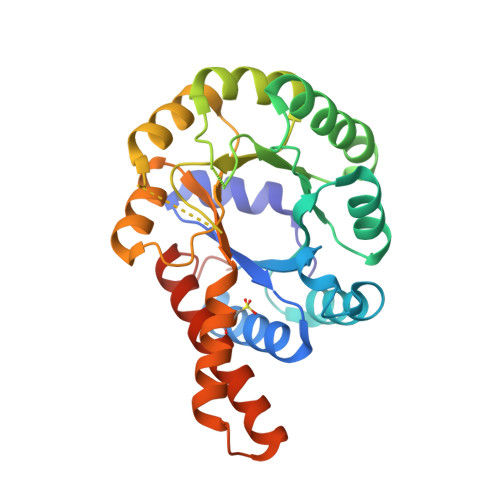Structural and Functional Characterization of YdjI, an Aldolase of Unknown Specificity inEscherichia coliK12.
Huddleston, J.P., Thoden, J.B., Dopkins, B.J., Narindoshvili, T., Fose, B.J., Holden, H.M., Raushel, F.M.(2019) Biochemistry 58: 3340-3353
- PubMed: 31322866
- DOI: https://doi.org/10.1021/acs.biochem.9b00326
- Primary Citation of Related Structures:
6OFU - PubMed Abstract:
The ydj gene cluster is found in 80% of sequenced Escherichia coli genomes and other closely related species in the human microbiome. On the basis of the annotations of the enzymes located in this cluster, it is expected that together they catalyze the catabolism of an unknown carbohydrate. The focus of this investigation is on YdjI, which is in the ydj gene cluster of E. coli K-12. It is predicted to be a class II aldolase of unknown function. Here we describe a structural and functional characterization of this enzyme. YdjI catalyzes the hydrogen/deuterium exchange of the pro- S hydrogen at C3 of dihydroxyacetone phosphate (DHAP). In the presence of DHAP, YdjI catalyzes an aldol condensation with a variety of aldo sugars. YdjI shows a strong preference for higher-order (seven-, eight-, and nine-carbon) monosaccharides with specific hydroxyl stereochemistries and a negatively charged terminus (carboxylate or phosphate). The best substrate is l-arabinuronic acid with an apparent k cat of 3.0 s -1 . The product, l- glycero -l- galacto -octuluronate-1-phosphate, has a k cat / K m value of 2.1 × 10 3 M -1 s -1 in the retro-aldol reaction with YdjI. This is the first recorded synthesis of l- glycero -l- galacto -octuluronate-1-phosphate and six similar carbohydrates. The crystal structure of YdjI, determined to a nominal resolution of 1.75 Å (Protein Data Bank entry 6OFU ), reveals unusual positions for two arginine residues located near the active site. Computational docking was utilized to distinguish preferable binding orientations for l- glycero -l- galacto -octuluronate-1-phosphate. These results indicate a possible alternative binding orientation for l- glycero -l- galacto -octuluronate-1-phosphate compared to that observed in other class II aldolases, which utilize shorter carbohydrate molecules.
Organizational Affiliation:
Department of Chemistry , Texas A&M University , College Station , Texas 77843 , United States.

















